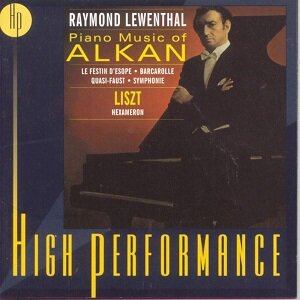
Charles-Valentin Alkan (1813-1888)
Etudes in All the Minor Keys, Op. 39 (No. 12), Le Festin d’Ésope
Barcarolle, Op. 65 No. 6
Grande Sonate, Op. 33 (II): Quasi-Faust
Etudes (Nos. 4, 5, 6. 7) in all the Minor Keys, Op. 39
Ferencz Liszt (1811–1886) & others
Hexaméron, S392
Raymond Lewenthal (piano)
rec. 1965-66, New York City,
Presto CD
RCA 09026 63310-2 [65]
Interest in Alkan, whose music makes up some two-thirds of the playing time of this disc, owes much to Ronald Smith (1922-2004) (review ~ review). Even earlier on the scene was US pianist Raymond Lewenthal (1923-88). It’s only to be regretted, however, that Lewenthal is captured only in extracts from Alkan’s suites or sequences.
Le Festin d’Ésope Op. 39 is the twelfth of the Etudes in All the Minor Keys. It is stormed through with firm and backboned playing. The whole is supremely articulated. Next comes the diminutive Barcarolle, Op. 65 No. 6. Here we are ushered into quiet serenity and intimacy in a style familiar from Chopin. Lewenthal conjures the intensity of a world turned charmingly in on itself. The second movement, Quasi-Faust, of the Grande Sonate Op. 33 sprays out devilment and dignity in equal measure. Back then to Op. 39 for the four Etudes (Nos. 4, 5, 6. 7) that comprise the four-movement Symphonie which runs to just 23 minutes. The Allegro moderato is an essay in mercurial fantasy. The tension of the dignified Marche funèbre sets the listener up for the flighty Menuet which rises stiffly to the occasion. The Mendelssohnian Finale is an Ariel flight which sprints transcendentally upwards to the heights of Lisztian drama.
The Hexaméron, a portmanteau showpiece was produced in tandem with Thalberg, Pixis, Herz, Czerny and, yes, Chopin – the piano lions of the time. That said, this multi-movement wardrobe of a piece is principally by Liszt who also arranged the Bellini theme (‘Suoni la tromba’ from I puritani) that forms the DNA of this piece. It is not entirely a Tower of Babel of prestidigitation. There is plenty of pianism in florid torrent but the structure is held together by waterfalls of fantasy (tr.16) and pensive poetry (tr.17). Nothing outstays its welcome. The recording is divided in ideally and princely fashion with 12 tracks for this flamboyant 21 minute piece.
The fulsomely meaty and protein-packed liner-notes, by Mr Lewenthal, run to some 16 pages. They give every appearance of being scrupulously presented with dates of writing declared. The whole is squired by two atmospheric photographs of this magus of a pianist – all in the aristocratic and slightly portentous manner reminiscent of Ronald Stevenson and Bernard Van Dieren.
The disc attests to resoundingly impressive work from Lewenthal and the RCA engineers (Max Wilcox and Richard Gardner) at Webster Hall, NYC in 1965-66. Michael O Drexler must also take part of the victory wreath for preparing the sixty year vintage analogue tapes with such mastery.
Utterly commanding playing is matched with the finest sound. These elements cast a spell that refuses to let you do anything other than succumb, flinch, brave it out and celebrate.
Presto did well to give this overwhelming collection, and today’s piano aficionados, and others a second chance.
Rob Barnett
Help us financially by purchasing from

Liszt
Introduction (Liszt)
Theme (Bellini)
Variation I (Sigismond Thalberg)
Variation II (Liszt)
Variation III (Johann Pixis)
Interlude I (Liszt)
Variation IV (Henri Herz)
Variation V (Czerny)
Interlude II (Liszt)
Variation VI (Chopin)
Interlude III (Liszt)
Finale (Liszt)


















